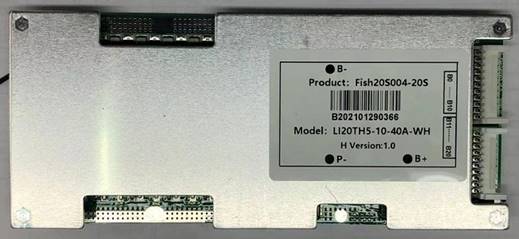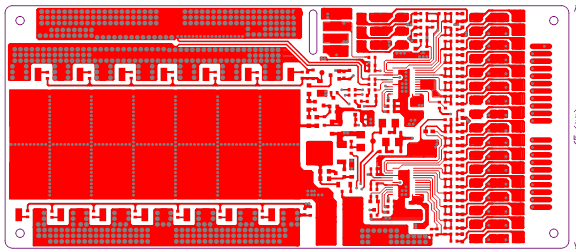The following is the introduction of high quality FY•X high quality 20S 60V/72V 50A Hardwar BMS for E-Motorcycles, hoping to help you better understand FY•X products. Welcome new and old customers to continue to cooperate with us to create a better future!
This FY•X high quality 20S 60V/72V 50A Hardwar BMS for E-Motorcycles is a protective board solution specially designed by Huizhou Feiyu New Energy Technology Co., Ltd. for 20-cell battery packs such as electric bicycles and motorcycles. It can be applied to lithium batteries with different chemical properties, such as lithium ion, lithium polymer, etc. The protection board has strong load capacity, and the maximum continuous current can be 35A.
● 20 batteries are protected in series;
● Charging and discharging voltage, temperature, overcurrent and other protection functions;
● Low power consumption.

Figure 1: BMS front view

Figure 2: Physical picture of the back of BMS
|
Details |
Min. |
Typ. |
Max |
Error |
Unit |
||
|
Battery |
|||||||
|
Battery Gas |
LiCoxNiyMnzO2 |
|
|||||
|
Battery Links |
20S |
|
|||||
|
Absolute Maximum Rating |
|||||||
|
Input Charging Voltage |
|
84 |
|
±1% |
V |
||
|
Input Charging Current |
|
20 |
30 |
|
A |
||
|
Output Discharging Voltage |
56 |
72 |
84 |
|
V |
||
|
Output Discharging Current |
|
35 |
40 |
|
A |
||
|
Continuous Output Discharging Current |
≤35 |
A |
|||||
|
Ambient Condition |
|||||||
|
Operating Temperature |
-20 |
|
75 |
|
℃ |
||
|
Humidity (No Water-Drop) |
0% |
|
|
|
RH |
||
|
Storage |
|||||||
|
Temperature |
-40 |
|
85 |
|
℃ |
||
|
Humidity (No Water-Drop) |
0% |
|
|
|
RH |
||
|
Protection Parameters保 |
|||||||
|
Over-Charge Voltage Protection |
|
4.220 |
|
±30mV |
V |
||
|
Over-Charge Voltage Protection Delay Time |
|
2 |
|
±1 |
S |
||
|
Over-Charge Voltage Protection Release |
|
4.100 |
|
±50mV |
V |
||
|
Over-Discharge Voltage Protection |
|
2.800 |
|
±80mV |
V |
||
|
Over-Discharge Voltage Protection Delay Time |
|
2 |
|
±1 |
S |
||
|
Over-Discharge Voltage Protection Release |
3.000 and disconnect load or charge |
±100mV |
V |
||||
|
Overcurrent charge protection1 (OCCP1) |
|
30 |
|
±8 |
A |
||
|
Overcurrent charge protection1 delay time |
|
2 |
|
±1 |
S |
||
|
Overcurrent charge protection1 release |
Release automatically after 8 seconds |
||||||
|
Discharge overcurrent 1 protection |
|
55 |
|
±8 |
A |
||
|
Discharge overcurrent 1 protection delay |
|
2 |
|
±1 |
S |
||
|
Discharge overcurrent 1 protection release |
Disconnect load or charge |
|
|||||
|
Discharge overcurrent 2 protection |
|
150 |
|
±15 |
A |
||
|
Discharge overcurrent 2 protection delay |
|
50 |
|
±20 |
ms |
||
|
Discharge overcurrent 2 protection release |
Disconnect load or charge |
|
|||||
|
Short circuit protection |
375A or above |
A |
|||||
|
Short circuit protection delay |
|
500 |
|
±150 |
us |
||
|
Short circuit protection release |
Disconnect load or charge |
|
|||||
|
Charging Temperature |
-5 |
65 |
|
±5 |
℃ |
||
|
Charging Temperature Protection Release |
0 |
55 |
|
±5 |
℃ |
||
|
Discharging Over-Temperature |
-25 |
70 |
|
±5 |
℃ |
||
|
Discharging Temperature Protection Release |
-20 |
60 |
|
±5 |
℃ |
||
|
|
|||||||
|
Current Consumption |
|||||||
|
SleepConsumption |
|
100 |
150 |
|
uA |
||
|
Over-DischargeConsumption |
|
50 |
100 |
|
uA |
||
Note: The discharge temperature protection release needs to meet the requirement that the temperature reaches the release value and the load needs to be disconnected to release or the temperature reaches the release value before charging.The above parameters are recommended values and the user can modify them according to the actual application.

Figure 7: Protection principle block diagram

Figure 8: Motherboard top-level wiring diagram

Figure 9: Motherboard bottom wiring diagram

Figure 10: Dimensions 150*65 Unit: mm Tolerance: ±0.5mm
Protection board thickness: less than 10mm (including components)

Figure 11: Protection board wiring diagram
|
Item |
Details |
||
|
B+ |
Connect to Positive Side of the pack. |
||
|
B- |
Connect to Negative Side of the pack. |
||
|
P- |
Charging and Discharging Negative Port. |
||
|
J1 |
1 |
BC0 |
Connect to Negative Side of Cell 1. |
|
2 |
BC1 |
Connect to Positive Side of Cell 1. |
|
|
3 |
BC2 |
Connect to Positive Side of Cell 2. |
|
|
4 |
BC3 |
Connect to Positive Side of Cell 3. |
|
|
5 |
BC4 |
Connect to Positive Side of Cell 4. |
|
|
6 |
BC5 |
Connect to Positive Side of Cell 5. |
|
|
7 |
BC6 |
Connect to Positive Side of Cell 6. |
|
|
8 |
BC7 |
Connect to Positive Side of Cell 7. |
|
|
9 |
BC8 |
Cnnect to Positive Side of Cell 8. |
|
|
10 |
BC9 |
Connect to Positive Side of Cell 9. |
|
|
11 |
BC10 |
Connect to Positive Side of Cell 10. |
|
|
J2 |
1 |
BC11 |
Connect to Negative Side of Cell 11. |
|
2 |
BC12 |
Connect to Positive Side of Cell 12. |
|
|
3 |
BC13 |
Connect to Positive Side of Cell 13. |
|
|
4 |
BC14 |
Connect to Positive Side of Cell 14. |
|
|
5 |
BC15 |
Connect to Positive Side of Cell 15. |
|
|
6 |
BC16 |
Connect to Positive Side of Cell 16. |
|
|
7 |
BC17 |
Connect to Positive Side of Cell 17. |
|
|
8 |
BC18 |
Connect to Positive Side of Cell 18. |
|
|
9 |
BC19 |
Connect to Positive Side of Cell 19. |
|
|
10 |
BC20 |
Connect to Positive Side of Cell 20. |
|
|
NTC |
temperature probe |
||

Figure 12: Schematic diagram of battery connection sequence
Warning: When connecting the protective plate to the battery cells or removing the protective plate from the battery pack, the following connection sequence and regulations must be followed; if operations are not performed in the required order, the components of the protective plate will be damaged, resulting in the protective plate being unable to protect the battery. core, causing serious consequences.
Preparation: According to the definition shown in Figure 11, connect the corresponding voltage detection cable to the corresponding battery core. Please pay attention to the order in which the sockets are marked.
Steps to install protective board:
Step 1: Weld the P- and wires to the corresponding positions of the protection board without connecting the charger and load.
Step 2: Connect the negative pole of the battery pack to B- of the protection board;
Step 3: Connect the positive terminal of the battery pack to B+ of the protection board;
Step 4: Connect the battery pack and battery rows to J1 of the protection board;
Step 5: Connect the battery pack and battery rows to J2 of the protection board;
Steps to remove the protective plate:
Step 1: Disconnect all chargers\loads
Step 2: Unplug the battery pack and battery strip connector J2;
Step 3: Unplug J1 of the battery pack battery strip;
Step 4: Remove the connecting wire connecting the positive electrode of the battery pack from the B+ pad of the protective plate
Step 5: Remove the connecting wire connecting the negative electrode of the battery pack from the B- pad of the protective plate
Additional notes: Please pay attention to electrostatic protection during production operations.
|
|
Device type |
model |
encapsulation |
brand |
Dosage |
Location |
|
1 |
Chip IC |
OZ7714 |
TSSOP24 |
O2 |
1PCS |
U1,U2 |
|
2 |
MOS tube |
CRST047N12N |
TO220 |
China Resources Micro |
12pcs |
M1,2,3,4,5,6,11,13,14,15,16,17 |
|
3 |
PCB |
Fish20S004 V1.0 |
150*65*1.6mm |
brand |
1PCS |
|
Note: If SMD transistors and MOS tubes are out of stock, our company may replace them with other models of similar specifications.

1 Huizhou Feiyu New Energy Technology Co., Ltd. logo;
2 Protection board model - (This protection board model is Fish20S004, other types of protection boards are marked, there is no limit to the number of characters in this item)
3. The number of battery strings supported by the required protection board - (this model of protection board is suitable for 17S battery packs);
4 Charging current value - 20A means the maximum support for continuous charging is 20A;
5 Discharge current value - 35A means maximum support for continuous 35A charging;
6 Balance resistance size - fill in the value directly, for example, 100R, then the balance resistance is 100 ohms;
7 Battery type - one digit, the specific serial number indicates the battery type as follows;
|
1 |
Polymer |
|
2 |
LiMnO2 |
|
3 |
LiCoO2 |
|
4 |
LiCoxNiyMnzO2 |
|
5 |
LiFePO4 |
8 Communication method - one letter represents a communication method, I represents IIC communication, U represents UART communication, R represents RS485 communication, C represents CAN communication, H represents HDQ communication, S represents RS232 communication, 0 represents no communication, and the product UC represents UART+CAN dual communication;
9 Hardware version - V1.0 means the hardware version is version 1.0.
10 The model number of this protection board is: WH-Fish20S004-20S-15A-35A-150R-4-0-V1.0. Please place the order according to this model number when placing bulk orders.
1. When performing charge and discharge tests on the battery pack with the protective board installed, please do not use a battery aging cabinet to measure the voltage of each cell in the battery pack, otherwise the protective board and battery may be damaged. .
2. This protection board does not have a 0V charging function. Once the battery reaches 0V, the battery performance will be severely degraded and may even be damaged. In order not to damage the battery, the user should not charge the battery for a long time (the battery pack capacity is greater than 15AH, and the storage exceeds 1 Months) When not in use, it needs to be charged regularly to replenish the battery; when in use, it must be charged in time within 12 hours after being discharged to prevent the battery from being discharged to 0V due to self-consumption. Customers are required to have an obvious sign on the battery casing that the user regularly maintains the battery.
3. This protection board does not have reverse charging protection function. If the polarity of the charger is reversed, the protection board may be damaged.
4. This protective board shall not be used in medical products or products that may affect personal safety.
5. Our company will not be responsible for any accidents caused by the above reasons during the production, storage, transportation and use of the product.
6. This specification is a performance confirmation standard. If the performance required by this specification is met, our company will change the model or brand of some materials according to the order materials without further notification.